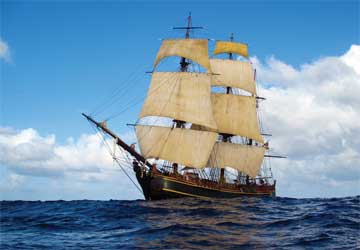Marlon Brando once walked these decks. So, too, did Trevor Howard, Charlton Heston, Johnny Depp and countless other swashbuckler wannabes whose faces we know, if not their names.
The decks in question belong to the replica ship Bounty built for the 1962 film Mutiny on the Bounty. This was a remake of the 1935 version that starred Clark Gable and Charles Laughton. In the 1962 film, a young Brando played Fletcher Christian rebelling against Howard’s Capt. William Bligh.
This incarnation of Bounty was built in Lunenburg, Nova Scotia, in 1960-1961. An immense ship, Bounty is 180 feet overall with a 32-foot beam and a draft of 13 feet. Bounty carries 10,000 square feet of sail, has more than 10 miles of Kevlar-core standing rigging, and is constructed of more than 400,000 board feet of lumber. The vessel is a floating anachronism and a testament to owner Robert Hansen’s devotion and responsible stewardship.
After the 1962 filming was complete, MGM wanted to scuttle the ship. Bounty was only saved through the intervention of Brando, who during the course of filming met a Tahitian beauty, married her, and bought some islands in the South Pacific.
For years Bounty rested on her laurels in St. Petersburg, Fla., serving as a popular tourist attraction. In 1986 Ted Turner acquired the film library of MGM along with Bounty. After a long hiatus Bounty once again was ready for her close-up. The film was Treasure Island, done in 1989, starring Heston.
In 1993, Bounty was donated to the Fall River Chamber Foundation in Massachusetts. In 2001 the ship was sold to Hansen and it is now operated by the HMS Bounty Organization LLC. Greenport, N.Y., is given as the homeport on the transom but Bounty, like a rock star, is always on the road, so to speak. Visiting as many as 27 ports yearly, Bounty rarely makes it back to Greenport.
The next big break for Bounty came in 2005 when Disney hired the boat to be in the film Pirates of the Caribbean: Dead Man’s Chest. The vessel was hauled in Alabama and given the kind of attention that movie studios have always lavished on their stars.
Despite all the Hollywood fluff, Bounty is at heart a working sailing ship and has already made two trans-Atlantic passages under the guidance of Capt. Robin Walbridge, who has been in command for the past 15 years. Capt. Walbridge bears no resemblance to any portrayal of Bligh save for the short sailor’s queue that peeks out from beneath his hat. He is a thoroughly modern mariner, holding a 1,600-ton license and a resume that includes the names of many well known tall ships.
Although Bounty is outfitted with all modern navigational equipment, including chart plotter, radar and GPS, when Walbridge takes the ship offshore he navigates using traditional celestial navigation. “When we go offshore,” Walbridge said, “we shut down all the electronics except the radar at night. To calculate speed, Walbridge no longer uses the taffrail log having lost too many spinners at sea. The crew now measures speed by measuring 100 feet on the deck and then tossing a chip of wood over the side marking the time.
For his celestial navigation Capt. Walbridge uses an older Astra 111B sextant as well as the least expensive, vernier scale, plastic Davis which he finds perfectly adequate. He prefers shooting stars and encourages the crew to do sun sights. To find stars he uses the Rude Star Finder and reduces the sights using H.O. 249. He is an early riser so he usually is up on deck to do morning stars. He lets the crew get their practice, teaching them how to take noon sights. “If you’re going to sail on a 200-year-old boat,” he says, “then we should navigate in the old way.”
As for using the sextant, Walbridge is satisfied with an accuracy of two miles or less and he is serious about his navigation. “I use the sextant to navigate, not to impress.”
While underway there are five crew on each four-hour watch. At sea he dogs the watch once a week.
Let’s join Capt. Walbridge aboard Bounty on the way to the Azores in 2009. Bounty actually made landfall in October 2009. For the sake of this problem we will use the 2010 Nautical Almanac. Capt. Walbridge does a morning star sight. The DR is 41° 43’ N by 25° 42’ W. There is no index error and no watch error. The height of eye is 16 feet. The day in question is October 7. The captain shoots three stars: Regulus at 7:01:15 GMT and gets an Hs of 32° 31.0’. He then shoots Dubhe at 7:02:25 and gets an Hs of 44° 47.7’. The final star he shoots is Procyon at 7:03:10 with an Hs of 49° 40.4’.
We will be using H.O. 249 Vol. I for Selected Stars, the 2010 Epoch. Any other solution will yield different results. Also, there is an assumed latitude of 41° N.
A: Find LHA Aires for time of sights
B: Reduce all three sights and find the Ho’s
C: Plot the LOPs. What is fix position?
Answers:
A: LHA Aires 96°
B: Ho Regulus is 32° 25.6’
Ho Dubhe is 44° 42.9’
Ho Procyon is 49° 35.7’
C: 41° 45’ N, 25° 56’ W

